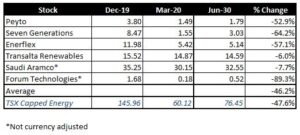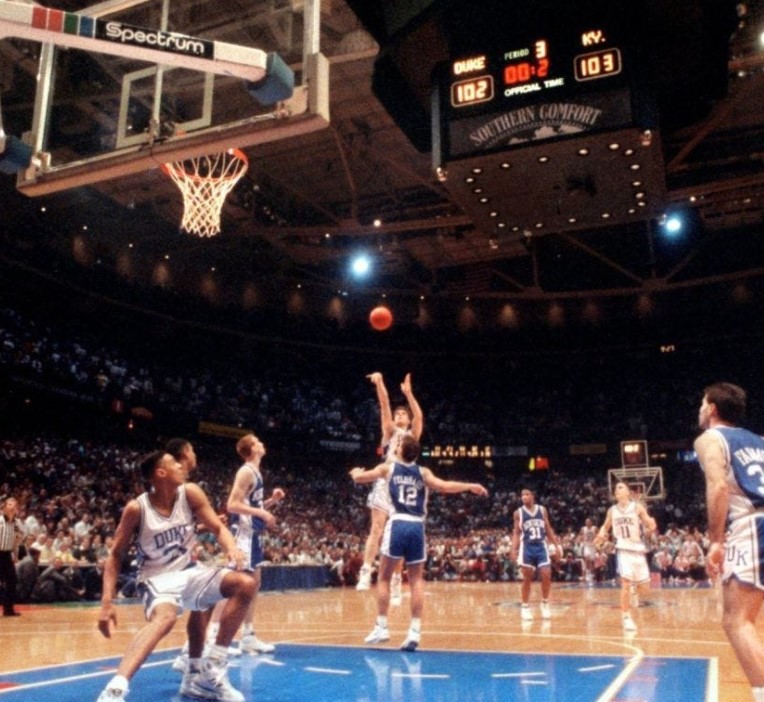Well folks, it’s official. We are halfway through 2020 and I have to say that this past six months has been the longest decade ever. But we’ll make it, I swear.
And with that halfway point reached, it is now time, yet again, to do a review of my 2020 Fearless Forecast, which I have now officially renamed the “Living on a Prayer” since any and all sanity and substance has been wrung out of the peerless prognostications due to COVID, price wars, economic shutdowns and all the attendant chaos that has been the story of all of our lives since those heady and hopeful early days in January.
While in Q1 I decided to just give myself a pass on all my forecasts because the world was just beginning to grasp the extent of the shutdowns, I will attempt this quarter to provide a little more of a critical eye to what I floated out there since with the passage of time, shocks should, in most circumstances, even out.
Which means of course that with economies around the world slowly reopening, some modest sense of (new) normalcy is returning.
Plus I did recast some of my general themes in light of the pandemic so there’s that aspect that must be accounted for.
So, with all that out of the way and without further ado, here goes nothing. And, as always, a warning. Please do not make investment decisions based on this forecast, unless you want to, I can’t really stop you, but seriously folks, that isn’t the purpose here. And when you see my stock picks, you’ll know why you should never blindly follow the forecaster.
Broad Themes
Interestingly, my original forecast posited that the theme of civil unrest would still be topical, but that the largest influence on the globe would be the runup to and the eventual result of the US Presidential Election. I also suggested that Trump 2.0 would run on his economic record as opposed to the nationalist side-show that underpinned the 2016 run.
In retrospect, this seems really naïve, but absent COVID, probably had a good base in reality. More on civil unrest in a bit, but I do think the economy will still be front and centre in the upcoming election on the GOP side with Trump either trying to ride a wave of post-pandemic economic recovery or, in the event this takes longer, a campaign based on his proverbial “Only I can fix this.” The Democrats will clearly make the election about the pandemic response and the subsequent economic carnage.
Long story short, notwithstanding the pandemic, 2020 is still all about the US election, because the result will set the trajectory of the (as yet still) free world for the next four years.
Fortunately for Trump, his late 2019 and early 2020 already faltering economy and disastrous trade policies will be a distant memory come election season.
Unfortunately for Trump, the pandemic will be the primary election issue with systemic racism and white privilege being a close second. As a side note on the civil unrest issues in the United States and around the world, for sure this was not anticipated in my initial review, but it is always bubbling under the surface and in a world where Donald Trump uses all things race to fire up his base, you had to know that this was likely to come to the fore, even in a pandemic.
Ultimately, Trump-Pence will lose to Biden-Harris in November. That was my call in January and it stands today.
Looking around the rest of the world, I had expected that the Iran Crisis would continue to percolate and I expect that will continue to be the case, especially now that energy prices have collapsed and Iran has been ravaged by the pandemic. Internal unrest is likely to continue to rise in Iran and the US shows no sign of relaxing its pressure on the Iranian regime. As it becomes more isolated and desperate, it is not unreasonable to postulate, as many commentators have, that the Iranian regime will seek to destabilize other parts of the Middle East, in particular its arch nemesis Saudi Arabia, dragging the United States reluctantly into deeper conflict than it wants. And issuing an international arrest warrant for Donald Trump because he had that Iranian general killed isn’t likely to calm things down, but who knows, maybe the Donald likes the attention.
I know it sounds heartless, but humans, for all their nobility and charity in times of crisis, are still angry beings, given to waging war and fomenting conflict at will. A pandemic isn’t going to stop that, and in all reality may serve to exacerbate already volatile situations.
That’s why I believe that many countries in Africa are already on the edge (Burkina Faso, Ethiopia, Sudan) and places like Libya will remain powder kegs.
Aside from Iran, I suggested two major areas that had the potential to spiral out of control if left unattended.
The first was Venezuela which is in its 119th year of economic stagnation. With intensified US sanctions and a Russian benefactor who appears to be losing interest, Venezuela is an ongoing humanitarian crisis that threatens to boil over in a pandemic induced civil war.
The second area I flagged is the disputed Kashmir, a traditional area of conflict between India and Pakistan that has been threatening to blow up for decades. With the entire Indian sub-continent currently on lockdown, this will stay quiet for the time being, but India’s Modi has imperial type aspirations and everyone has a nuke. As I said in January – you have been warned. Pay attention. That said, apparently the border we really should be paying attention to is the India-China border because what says World War 3 more effectively than the two most populous countries in the world facing off.
On the energy and environment front, I suggested 2020 was going to be a year of transition and that the story wasn’t going to be Light Tight Oil. Rather it was going to be ESG (Environmental Social and Governance), a movement led by uber-boring rich white dudes like Steve Schwartzman, CEO of Blackstone (largest private equity fund in the world), former Bank of Canada/Bank of England Governor Mark Carney and other investor groups.
For a few months, this looked downright prophetic, but then with the crash in oil prices, all such conversation has taken a back seat.
But this doesn’t mean by any stretch of the imagination that the climate crisis has gone away. Opportunists on both sides of the debate are using the pandemic to reinforce their positions.
“If you think this is bad, wait for climate change”
“See how much we need oil and gas?”
“If we can mobilize this much capital for a disease, why can’t we do the same for a Green New Deal?”
“The climate movement has been set back a decade by this.”
Where is the answer? Somewhere in between. Climate still matters. So does cheap and affordable energy. There is no denying the critical role that fossil fuels play in keeping our supply chains moving. There is also no denying the disruptive nature of oil price volatility to global economies. If ever there was a case to diversify the energy mix away from oil it is made by the spurious and injurious actions of an impetuous millennial leader of a dictatorship with too much control of a critical resource.
Accordingly, I still think 2020 will be the year where emissions reducing solutions like nuclear power come back to the fore – and not just from fringy right-wing web sites, but instead an institutionally driven initiative from many levels of government.
And with coal now the most expensive fossil fuel out there, look for the transition away from coal to natural gas, renewables and nuclear to accelerate.
I suggested there is still a leading role for Canada to play in all this. Canada is already a global leader in ESG influenced fossil fuel production and we are a leading exporter of next generation nuclear technology.
On the oil and gas front, I suggested that with the Permian not being the main focus, we are projecting significant investment in offshore Africa, Latin America and non-Iran OPEC but not Canada. And up until March 7, that was exactly what was happening. But now, with demand still off in excess of 15%, prices rallying but stagnant and shut-ins the order of the day, the global capex picture is dire, off by as much as 30% for the year.
Grade? Pass – but you knew that.
Price of oil
Alright folks, here we go. This is the one everyone loves, the glory call and the one you should be basing all of your investment decisions on. Well here’s what I did at year end. After having my keester spanked by prices last year, I decided that I was going to play it safe. I was going to make a conservative call. Then that thing that happened, happened. And suddenly I look like a raging lunatic. To my credit, I was looking pretty good. Until that thing that happened, happened.
Review.
First off, I expected oil and gas demand to increase by about 1%, as it does every year.
Against that was record oil production in the United States offset by big cuts from OPEC/NOPEC and substantial spare capacity in Saudi Arabia. Inventories were to decline, there was a political risk premium, recovering GDP growth around the world… Against that was EV growth, what to make of Venezuela and Libya, cheating.
I was concerned. So I low balled my call. I went with sideways pricing because I thought there was too much supply. Then I got knocked on the head. 25 million bpd demand destruction starting Mid-March. Price war. To my credit, I also predicted lots of volatility! But I never expected a negative WTI price.
My original year end price for WTI was $62.17 and my average price for the year was $60.38 but at the end of Q1, with prices in the $20’s I revised my prices down by $20 each so a new year end price of $42.17 and an average for the year of $40.38. At the end of Q2 the price was $39.27 and the average price $38.27. So far, the right call.
Global growth in consumption at the end of the year will be -2%. Many pundits say it could be -5%. Potato
Grade – Pass.
Price of Natural Gas
Ah natural gas, even in a pandemic I can’t quit you!
The original call was based on gas consumption in the US being way up, exports of LNG growing rapidly and exports to Mexico also rising. At the time production was also rising, with associated gas from the Permian a major contributor. But even then, growth wasn’t limitless. I said the catalyst for gas is still a year or so out – LNG Canada, more export capacity out of the US, the completion of the coal to gas power conversion – this all takes additional time. It should be noted that gas production is rapidly declining in the United States with all the rigs are being parked and shale activity pulling back.
All that said, as a domestic market, the pandemic hasn’t been as bad for gas as it has been for oil.
My year end price for natural gas (NYMEX) was going to be $3.52 and an average price will be $2.96, up marginally from last year. I also predicted a better year for AECO than I think many Canadian producers are used to. So far, at the end of Q2 the price was $1.751 and the average was $1.82. With some demand destruction, it is hard to stick to my earlier call… but I am going to. I think supply is going to be more challenged than expected and when the continent gets back to work, it won’t be easy to turn it back on. God help me.
Production
The prediction in January was that US producers would take a breather in the Permian and that with scarce capital the pace of completions would slow and the rig count would stabilize at around the 600 level.
We projected that US production would continue to grow albeit slower. Based on year end production numbers of 12.9 million bpd of production we projected an exit production level of 13.3 million with additions happening in the second half and some decline in the first half. Under this low growth scenario, I predicted that drilling activity would decline by 10% year over year.
As luck would have it, I was half right. The first week of April the rig count dropped by 10%. And it kept dropping, and dropping. Production has already declined significantly and with the oil directed rig count down a staggering 73% since the end of 2019 production actually has nowhere to go but down through the end of 2020 and into 2021 when lack of activity and decline rates kick in.
Quarter end production estimates from EIA were around 11.0 million bpd. These are wrong. My new exit rate of production was set at 11.5 million bpd, this could be off by at least 1 million. It is ugly out there. LTO peaked in March, likely to never test those heights again.
In Canada, I was pretty bearish while we waited for egress issues to be solved. I suggested that activity levels would mirror last year with brownfield in the oilsands and pockets of conventional unconventional (tight oil, deep basin, condensate, liquids rich) activity in places like the Duvernay/Montney/Viking and the Bakken but not much in between.
So no growth above replacement of natural declines. Park those rigs for better times. Even ex-demand destruction, without takeaway capacity, Canada was a challenge.
I think this is now a pie in the sky scenario for Canada. With the capex cuts announced recently and rig counts testing lows not seen since Turner Valley was a thing, it will be hard to even hit a maintenance level of activity, but at least we don’t have the double existential whammy of absurdly high declines and a giant debt wall. 2021 can’t come soon enough for Canada’s oilpatch.
I suggested that OPEC production levels would depend on what happens with the new OPEC/NOPEC agreement at the various jump-off points through the year. The key to the agreement was the Saudi/Russia collaboration which was likely to continue at least until June but exploded on March 7. I thought OPEC/NOPEC output would be flat year over year and, ironically, I think that is a good forecast. It’s what happens between now and then that will matter. So far the OPEC+++++++++++ agreement is holding, but much musing about restoring some production in August which seems to me more price management than anything
The rest of the world was expected to deliver limited growth but acceleration as the year progresses with new projects in the North Sea, investments in Africa, Latin America, etc.
This is now clearly all out the window. Capex globally is likely set back at least three years. Ironically, even with all this demand destruction, in any “return to almost normal” scenario, we actually need production growth.
Grade – pass
M&A Activity
I expected a reasonable trend in M&A from 2019 to continue into 2020 as property consolidation, non-core asset sales and private equity investment all remain robust as the industry adjusts, yet again, to a new normal. I predicted M&A activity to be broadly based – upstream, downstream, oil, gas, services and everything in between in the United States but also increasingly in the great Canadian value play.
While this is clearly delayed as companies figure out where they stand or if they are even still solvent, out of chaos is opportunity so we anticipate that second half M&A activity is going to be pretty robust provided the capital markets don’t seize up. We expect US and international capital to start sniffing around Canada by the end of the year.
On the services side, we still like energy infrastructure and related industries and see that as an area where Canada will see a fair amount of activity. Mid and downstream oriented companies will continue to be of interest to strategic consolidators and private equity.
These projects will continue notwithstanding the pandemic and price rout. These are long term projects in the national interest which underscores the fact that Canada is a currency advantaged, rational valuation and stable market for consolidators.
And I’m sticking to that theme.
Canadian Dollar
We predicted stability for the Canadian dollar this year and, aside from a 15% plunge due to the oil price pandemic double whammy, the Canadian dollar should actually remain a fairly stable currency, even with the massive stimulus being thrown at the economy since, all things being relative, Canada was pretty stable before and will be after. I expected the Canadian dollar to reach perhaps as high as $0.78 by year end – why change now.
Infrastructure
Finally, right? I predicted that the early to mid stage of an infrastructure supercycle in Canada would continue well into the mid-2020s. My predictions…
- Line 3 complete and operational by year end – seems like this has been delayed again. Seriously guys, get it together.
- TransMountain Expansion well underway with multiple spreads operating during the year in Alberta and BC. This is happening and the Supreme Court of Canada just recently cleared the last appeal hurdle.
- Coastal Gas Link continuing notwithstanding current challenges. This was a good prediction and is coming to pass.
- Keystone XL – at the time without an FID was a real downer for me. I expected it to be a victim of the US election. Kudos to Jason Kenney, the Alberta Government and TC Energy for inking a deal at the darkest hour to get this critical energy infrastructure moving forward. Which of course subsequently got delayed and, of course, is going to be a victim of the US election unless Trudeau can work some negotiating magic with Grandpa Joe. Of course, in the unlikely event Trump wins, it’s all pipelines all the time.
I thought we might get one more LNG FID this year but clearly we are going to have to wait. But with the host of multi-billion and hundred million-dollar petrochemical plants on the books as well as wind and solar investments and a federal government intent on opening the fiscal hydrant, spending is going to happen. In Canada of all places!
Stock Picks
Wow. My energy stocks. Whoop dee doo. This, as they say, is going to be interesting – I haven’t even looked at the stock market in months, let alone the pooches parade that is my Fearless Forecast portfolio.
True to my rules, I pick two Canadian E&P’s as well as two service companies and, finally, one non-Canadian producer and service company.
Let’s review these genius picks.
Pick #1 was Peyto. Gassy. Makes money in lousy markets.
Pick #2 was Seven Generations. No real logic. It’s more oily than Peyto with similar fundamentals. Merp.
On the large cap Canadian service side, I picked Enerflex mainly for its global market and relative stability.
Pick #4 was TransAlta Renewables, just to show that an oil and gas scribe can grow adapt to a new market.
I gave up on picking a US producer and instead went with Saudi Aramco. Hey – in the current market, if you have to own an oil and gas stock, you may as well own the one that controls the market.
On the service side, I also went global and picked Forum Technologies. Beaten down, chewed up and spat out. What could go wrong?

Wow. Maybe it is time to invest in renewables. (ducks)
Grade? Pass. Barely.
Office Cat
I think it’s safe to say this is officially done. Good while it lasted.
Stormont Capital Crude Coffee
Another great conversation.
Taking this week off to go ride horses, but back at it July 14. Email me if you want to participate at sparnell@stormontcapital.com
Prices as at July 3, 2020
- Oil
- Oil storage was… down. (kind of expected – does no one read the news?)
- Production was … down?
- OPEC+++++ agreed to maintain cuts
- Natural Gas
- Storage was up, historically very high; consumption down; production flat; exports flat.
- WTI Crude: $40.23 ($38.06)
- Western Canada Select: $31.35 ($28.56)
- AECO Spot: $1.59 ($1.848)
- NYMEX Gas: $1.762 ($1.556)
- US/Canadian Dollar: $0.7358 ($0.7328)
Highlights
- As at June 26, 2020, US crude oil supplies were at 533.5 million barrels, a decrease of 7.2 million barrels from the previous week and a increase of 65.0 million barrels from last year.
- The number of days oil supply in storage is 38.8 compared to 27.2 last year at this time.
- Production was unchanged for the week at 11.000 million barrels per day, which of course we know is impossible. Production last year at the same time was 12.200 million barrels per day.
- Imports fell to 5.969 million barrels from 6.540 million barrels per day compared to 7.585 million barrels per day last year.
- Crude exports from the US fell to 3.092 million barrels per day from 3.157 million barrels per day last week compared to 2.990 million barrels per day a year ago
- Canadian exports to the US fell to 3.154 million barrels a day from 3.229 million barrels per day last week
- Refinery inputs increased during the current week to 14.003 million barrels per day
- As at June 24, 2020, US natural gas in storage was 3,012 billion cubic feet (Bcf), which is 18% above the 5-year average and about 33% higher than last year’s level, following an implied net injection of 120 Bcf during the report week
- Overall U.S. natural gas consumption rose 9.8% during the report week.
- Production was down 0.3% for the week. Imports from Canada rose 13.0% from the week before. Exports to Mexico were up 6.4%
- LNG exports totaled 25 Bcf
- As of July 3, 2020, the Canadian rig count increased 4 to 18 (AB – 9; BC – 5; SK – 2; MB – 0; Other – 2). Rig count for the same period last year was 58.
- US Onshore Oil rig count at July 3, 2020 is at 185, down 3 from the week prior.
- Peak rig count was October 10, 2014 at 1,609
- Natural gas rigs drilling in the United States is up 1 at 76
- Peak rig count before the downturn was November 11, 2014 at 356 (note the actual peak gas rig count was 1,606 on August 29, 2008)
- Offshore rig count was up 1 at 12.
- Offshore peak rig count at January 1, 2015 was 55
US split of Oil vs Gas rigs is 70%/30%, in Canada the split is 66%/34%
Trump Watch: Now he wants masks? The Lone Ranger!
Kenney Watch (new!): Big economic plan! Everyone needs to move to Alberta!
Trudeau Watch (for balance): WE.









